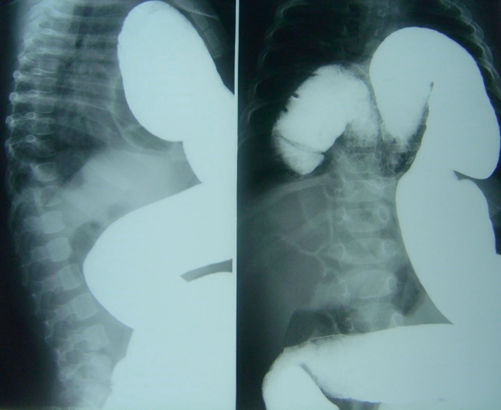Fig. 48.1
Barium enema showing colonic herniation into a right Morgagni’s hernia (a) and colonic herniation into a left Morgagni’s hernia (b)
Morgagni’s hernia can be bilateral (Fig. 48.2).

Fig. 48.2
Barium enema showing colonic herniation into bilateral Morgagni’s hernia
Morgagni’s hernia is slightly more common in females .
Presentation
Most Morgagni’s hernias present later in life and are generally asymptomatic discovered accidentally or during the evaluation of other nonrelated conditions.
Rarely Morgagni’s hernia present in the newborn period with respiratory distress at birth similar to Bochdalek hernia .
Morgagni’s hernias may also be the cause of recurrent chest infections and nonspecific gastrointestinal symptoms.
Morgagni’s hernia may also present with cough, dyspnea, and upper abdominal discomfort, fullness, bloating and vomiting.
Morgagni’s hernia may be discovered as a result of an increase in intra-abdominal pressure secondary to:
Trauma
Pregnancy
Obesity
Vetriculo-peritoneal shunt
Associated Anomalies
Morgagnis’s hernia is well known to be associated with other congenital anomalies. These include :
Congenital heart disease which is reported in up to 80 % of patients.
Down’s syndrome (14–35 %). It is well known that children with Down’s syndrome can have other muscular defects such as ventral hernia and diastasis recti. This association as well as that with Morgagni’s hernia suggests a possible muscular deficiency of the ventral paramedian segment of the body in these patients.
Pentalogy of Cantrell, Noonan syndrome, Prader–Willi syndrome, and Turner syndrome.
Malrotation in up to 30 % of patients. This must be kept in mind intraoperatively to obviate the risk of postoperative volvulus .
Diagnosis
The majority of Morgagni hernias are right sided .
Stay updated, free articles. Join our Telegram channel

Full access? Get Clinical Tree


